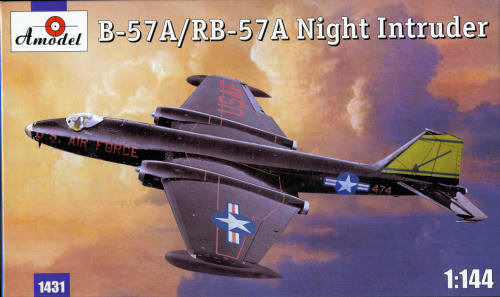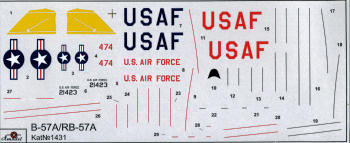
| KIT #: | 1431 |
| PRICE: | $15.45 from www.scale-model-kits.com |
| DECALS: | Two Optons |
| REVIEWER: | Scott Van Aken |
| NOTES: |

| HISTORY |
The English Electric Canberra is a first-generation jet-powered light bomber manufactured in large numbers through the 1950s. It proved to be highly adaptable, serving in such varied roles for tactical bombing, photographic, electronics, and meteorological reconnaissance. The Canberra remained in service with the Royal Air Force until 23 June 2006, 57 years after its first flight.
The Canberra entered US service as the result of a fly-off between it and the XB-51 for a medium jet bomber competition. The Canberra was chosen and Martin, the designer of the XB-51, was picked as the major contractor. Though the first two B-57As were delivered from the UK, all the rest of the Canberras were built in the US. The B-57A variants were nearly identical to the British aircraft aside from some internal equipment differences and US built engines. Generally, crews did not like the standard canopy and the type had a modified cockpit section for the B-57B and later versions.
While the USAF found the B-57A lacking, the photo reconnaissance RB-57A saw some operational use. First flying in October 1953, RB-57As fully equipped the 363rd Tactical Reconnaissance Wing at Shaw Air Force Base by July 1954. The aircraft were also deployed with USAF squadrons in Germany, France, and Japan. However, operational readiness was poor and the aircraft suffered from significant production delays because of engine problems. Wright had subcontracted production of J65 engines to Buick, which resulted in slow deliveries and a tendency to burn oil, filling the cockpit with smoke. The problems were ameliorated when Wright took over engine production in 1954. RB-57As also suffered from a high accident rate caused in part by poor single-engine handling. This resulted in the entire fleet spending much of 1955 on the ground. By 1958, all RB-57A craft were replaced in active service by the Douglas RB-66B and McDonnell RF-101A. Air National Guard units extensively used the RB-57A for photographic surveys of the United States until 1971.
Two RB-57As were used by the Republic of China Air Force for reconnaissance missions over China; one was shot down by a Chinese Mikoyan-Gurevich MiG-17 on February 18, 1958 and the pilot killed. In 1959, two RB-57Ds were delivered to replace the A-types, but one of them was shot down over China by a SA-2 Guideline missile, marking the very first successful operational engagement of surface-to-air missiles. Two other RB-57As were used by the Federal Aviation Administration to plan high-altitude airways for the upcoming jet passenger aircraft.
A number of RB-57s were used by the 7499th Support Group at Wiesbaden in "Heart Throb" reconnaissance missions over Europe.
Starting in 1959, Martin began to modify retired RB-57As with electronic countermeasures (ECM) equipment in the bomb bay. Redesignated EB-57A, these aircraft were deployed with Defense Systems Evaluation Squadrons which played the role of aggressors to train the friendly air defense units in the art of electronic warfare. Subsequent bomber variants were also modified to fulfill this role.
| THE KIT |
 Continuing with their 1/144 Canberra series, we have the initial production US Canberras, the B-57A and RB-57A. As these are basically identical to RAF Canberras, it is no surprise that the sprues are the same as in their earlier offering. This kit is highly sectional with separate nose, wing section and tail section. This is to allow all the different variations of the type to be built by simply swapping out what is needed. Typical of most 1/144 kits, the cockpit is very basic consisting of little more than a seat, but then, little can be seen in the cockpit of a Canberra anyway. It leaves plenty of room for the inevitable nose weight. The center section has optional bomb bays. One with the door closed and the other with it open an showing a load of six bombs. The plastic is nicely formed without any obvious molding glitches aside from lower section of one of the tip tanks, which has a considerable number of sink areas. The clear canopy is quite thick so perhaps it is best that there is little cockpit detail. The kit can be built with or without the tip tanks, but these were most often seen with them.
Continuing with their 1/144 Canberra series, we have the initial production US Canberras, the B-57A and RB-57A. As these are basically identical to RAF Canberras, it is no surprise that the sprues are the same as in their earlier offering. This kit is highly sectional with separate nose, wing section and tail section. This is to allow all the different variations of the type to be built by simply swapping out what is needed. Typical of most 1/144 kits, the cockpit is very basic consisting of little more than a seat, but then, little can be seen in the cockpit of a Canberra anyway. It leaves plenty of room for the inevitable nose weight. The center section has optional bomb bays. One with the door closed and the other with it open an showing a load of six bombs. The plastic is nicely formed without any obvious molding glitches aside from lower section of one of the tip tanks, which has a considerable number of sink areas. The clear canopy is quite thick so perhaps it is best that there is little cockpit detail. The kit can be built with or without the tip tanks, but these were most often seen with them.
From the experience of building the B.(I)8, I can assume that this will also need either the nose gear lengthened or the main gear shortened as it sits will a bit too much 'tail up'. The plane should sit nose low, but not to the extent I've seen. The kit does offer optional intake bullets and these are shorter than used on RAF versions as the USAF had slightly different engine intakes. It may be a good idea to test fit these as the RAF ones stuck out too far on my previous build. The kit also provides a part to simulate the additional intakes under the forward engine cowling that were typical of US Canberras.
 Instructions are well done and use Humbrol paint references. There are markings for two planes. One is a rather non-descript overall unpainted metal version, while the other is an RB-57A with the 10th TRW based in the UK as shown on the box art. The kit instructions imply that the recce version also has a full operating bomb bay with bombs, but I believe that the bomb bay was filled with cameras on the RB-57 version. If it is otherwise, I'd like to hear about it. No camera windows are supplied so the builder is on his own in this regard. Decals are nicely printed and previous experience has shown that they work very well, though are very thin. It would have been nice to have had at least an ANG option for the overall natural metal version as several guard units flew the early Canberra.
Instructions are well done and use Humbrol paint references. There are markings for two planes. One is a rather non-descript overall unpainted metal version, while the other is an RB-57A with the 10th TRW based in the UK as shown on the box art. The kit instructions imply that the recce version also has a full operating bomb bay with bombs, but I believe that the bomb bay was filled with cameras on the RB-57 version. If it is otherwise, I'd like to hear about it. No camera windows are supplied so the builder is on his own in this regard. Decals are nicely printed and previous experience has shown that they work very well, though are very thin. It would have been nice to have had at least an ANG option for the overall natural metal version as several guard units flew the early Canberra.
| CONCLUSIONS |
With careful construction, this will make into a very nice model that will look great on your shelves. We can only hope that a bonafide B-57B and later will be coming from Amodel. They have picked a great subject.
| REFERENCES |
http://en.wikipedia.org/wiki/B-57_Canberra November 2009
Thanks to www.scale-model-kits.com for the preview kit. Get yours at the link at a discount. If you would like your product reviewed fairly and fairly quickly, please contact the editor or see other details in the Note to Contributors.